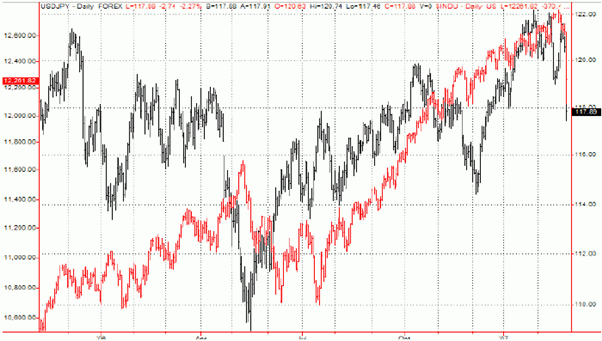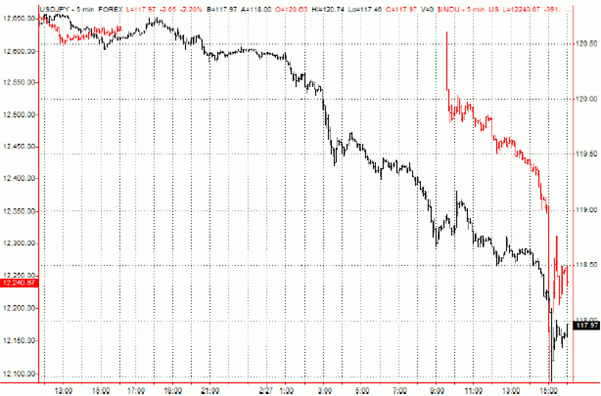| Is This a Major Pivot Point into a Recession? |
| By John Kicklighter |
Published
02/27/2007
|
Stocks , Options , Futures , Currency
|
Unrated
|
|
|
|
Is This a Major Pivot Point into a Recession?
Over the past few years, the financial markets have become very speculative and highly leveraged. Today, we have seen the consequences of that aggressive risk appetite. On an intraday basis, the Dow hit a low of 12,086 which represents a drop of over 500 pips, and is the largest move that we have seen in at least 3 years. Risk appetite is plunging as investors bail out of nearly all assets. Even gold has not escaped the liquidation. Prices have fallen over $20 since yesterday’s close. The moves have been substantial and February 27, 2007 will either go down as a major historical turning point for the financial markets or an unparalleled buying opportunity.
The foreign exchange market has provided a great clue into what is behind this move. The Japanese Yen, which has long been the primary funding currency for a lot of these speculative investments has skyrocketed. The Yen is now trading at a 12 month high against the US dollar and is closing in on its year to date highs against many of the other major currencies. The 9 percent drop in the Chinese stock market is being quoted as the initial trigger for the drop, but the broadness of the liquidation suggests that we have just seen a major shift in investor risk appetite.
The first chart below shows the close correlation between the Dow (Red line) and USD/JPY (black line) over the past few months. For the most part, USD/JPY has even been a leading indicator for the moves in the Dow. The second chart is a more granular look at the price action. USD/JPY began drop to at 1am EST last night with virtually no retracement. The Dow gapped at the open, but for those watching USD/JPY, the continual drop in the currency pair foreshadowed the continual drop in the Dow.


Don’t Blame It on Just China
Although China is a big global player and many US companies are sensitive to the country’s growth, last night’s drop in the stock market represented nothing more than an overdue correction. China’s economy will still grow at near double digits and its rampant demand for commodities will not be changing anytime soon. There are fears that the government could take measures to slow down the rally in the stock market, but like the revaluation in its currency, any measures will most likely be gradual.
Instead, the moves today represent concerns about US growth. Former Federal Reserve Chairman Alan Greenspan started it all this weekend when he brought up the word RECESSION. Even though he is no longer the Fed Chairman, his view on the economy still moves markets. Over the past few days, both the Financial Times and the Wall Street Journal have had extensive coverage about the problems in the sub prime mortgage market. According to the WSJ, banks are holding the lowest level of reserves to cover bad loans since 1990. With approximately $600 billion more adjustable rate mortgages to be reset to the higher market rate this year, two thirds of which are sub-prime, the risks for delinquencies and foreclosures are substantial. A report today indicated that loan delinquencies have already reached a 4 year high. A blowup in the sub-prime market will not only hurt the banks that have extended these loans, but also the borrowers. If homeowners do not have enough money to pay their mortgage, they will not have enough money to make discretionary purchases. As a result, consumer spending and retail sales in the months ahead could suffer and potentially even trigger a recession. In this type of environment, the Federal Reserve will have no choice but to accelerate monetary easing, if not only to pacify the financial markets.
After having already made great profits being long the Dow and the short the Japanese Yen, leveraged traders may not be as easily willing to get back into the market at this point, especially given the risks that the US economy faces. In fact, the liquidation could exacerbate as more traders bail out of risky assets.
Major players are getting stopped out of their long trades and we expect more to come. The Dow dropped 200 points intraday in a matter of minutes while USD/JPY dropped 100 pips in a blink of an eye. The quick and sharp reversal in the Dow and the far milder reversal in the dollar is clear indication that some big money was being stopped out.
More to Come?
An unwinding of this sort of degree is usually not just a one day affair. We could see further gains in the Japanese Yen against the high yielders such as the Australian dollar, New Zealand dollar and British pound. This may especially be true as repatriation increases ahead of the Japanese fiscal year end on March 31st. After record profits in 2006, today’s liquidation may be yet another reason for these corporations to bring some money back home and to shore up their balance sheets. Their buying could lead to more selling by hedge funds and other leveraged traders who have used the Japanese Yen as a cheap funding vehicle for their long stock and commodity trades.
Richard Lee is a Currency Strategist at FXCM.
|